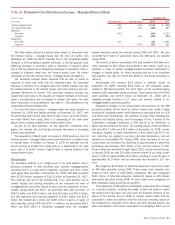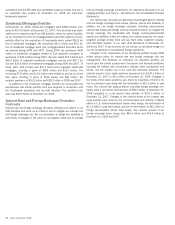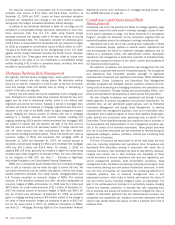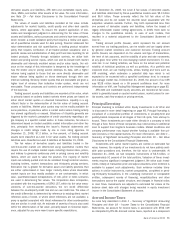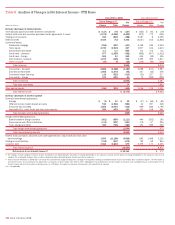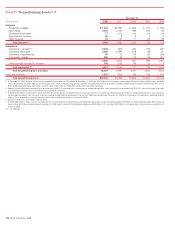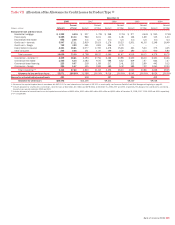Bank of America 2008 Annual Report Download - page 98
Download and view the complete annual report
Please find page 98 of the 2008 Bank of America annual report below. You can navigate through the pages in the report by either clicking on the pages listed below, or by using the keyword search tool below to find specific information within the annual report.of accrued expenses and other liabilities on our Consolidated Balance
Sheet, represents the net amount of current income taxes we expect to
pay to or receive from various taxing jurisdictions attributable to our oper-
ations to date. We currently file income tax returns in more than 100
jurisdictions and consider many factors – including statutory, judicial and
regulatory guidance – in estimating the appropriate accrued income taxes
for each jurisdiction.
In applying the principles of SFAS 109, we monitor relevant tax author-
ities and change our estimate of accrued income taxes due to changes in
income tax laws and their interpretation by the courts and regulatory
authorities. These revisions of our estimate of accrued income taxes,
which also may result from our own income tax planning and from the
resolution of income tax controversies, may be material to our operating
results for any given period.
Goodwill and Intangible Assets
The nature of and accounting for goodwill and intangible assets is dis-
cussed in detail in Note 1 – Summary of Significant Accounting Principles
and Note 10 – Goodwill and Intangible Assets to the Consolidated Finan-
cial Statements. Goodwill is reviewed for potential impairment at the
reporting unit level on an annual basis, which for the Corporation is per-
formed at June 30 or in interim periods if events or circumstances
indicate a potential impairment. As reporting units are determined after
an acquisition or evolve with changes in business strategy, goodwill is
assigned and it no longer retains its association with a particular acquis-
ition. All of the revenue streams and related activities of a reporting unit,
whether acquired or organic, are available to support the value of the
goodwill. The reporting units utilized for this test were those that are one
level below the business segments identified on page 32 (e.g., Card Serv-
ices, MHEIS, CMAS and Columbia).
Under applicable accounting standards, goodwill impairment analysis is
a two-step test. The first step of the goodwill impairment test compares
the fair value of the reporting unit with its carrying amount, including good-
will. If the fair value of the reporting unit exceeds its carrying amount,
goodwill of the reporting unit is considered not impaired; however, if the
carrying amount of the reporting unit exceeds its fair value, the second
step must be performed. The second step involves calculating an implied
fair value of goodwill for each reporting unit for which the first step
indicated possible impairment. The implied fair value of goodwill is
determined in the same manner as the amount of goodwill recognized in a
business combination, which is the excess of the fair value of the reporting
unit, as determined in the first step, over the aggregate fair values of the
individual assets, liabilities and identifiable intangibles as if the reporting
unit was being acquired in a business combination. The adjustments to
measure the assets, liabilities and intangibles at fair value are for the
purpose of measuring the implied fair value of goodwill and such adjust-
ments are not reflected in the Consolidated Balance Sheet. If the implied
fair value of goodwill exceeds the goodwill assigned to the reporting unit,
there is no impairment. If the goodwill assigned to a reporting unit exceeds
the implied fair value of the goodwill, an impairment charge is recorded for
the excess. An impairment loss recognized cannot exceed the amount of
goodwill assigned to a reporting unit, and the loss establishes a new basis
in the goodwill. Subsequent reversal of goodwill impairment losses is not
permitted under applicable accounting standards.
For intangible assets subject to amortization, impairment exists when
the carrying amount of the intangible asset exceeds its fair value. An
impairment loss will be recognized only if the carrying amount of the
intangible asset is not recoverable and exceeds its fair value. The carrying
amount of the intangible asset is not recoverable if it exceeds the sum of
the undiscounted cash flows expected to result from it. An intangible
asset subject to amortization shall be tested for recoverability whenever
events or changes in circumstances, such as a significant or adverse
change in the business climate that could affect the value of the
intangible asset, indicate that its carrying amount may not be recover-
able. An impairment loss is recorded to the extent the carrying amount of
the intangible asset exceeds its fair value.
Estimating the fair value of reporting units is a subjective process that
involves the use of estimates and judgments, particularly related to cash
flows, the appropriate discount rates and an applicable control premium.
The fair values of the reporting units were determined using a combina-
tion of valuation techniques consistent with the income approach and the
market approach and included the use of independent valuations. The fair
values of the intangible assets were determined using the income
approach. For purposes of the income approach, discounted cash flows
were calculated by taking the net present value of estimated cash flows
using a combination of historical results, estimated future cash flows and
an appropriate price to earnings multiple. Our discounted cash flow
employs a capital asset pricing model in estimating the discount rate
(i.e., cost of equity financing) for each reporting unit. The inputs to this
model include: risk-free rate of return; beta, a measure of the level of
non-diversifiable risk associated with comparable companies for each
specific reporting unit; market equity risk premium; and in certain cases
an unsystematic (company-specific) risk factor. The unsystematic risk
factor is the input that specifically addresses uncertainty related to our
projections of earnings and growth, including the uncertainty related to
loss expectations. We use our internal forecasts to estimate future cash
flows and actual results may differ from forecasted results. Cash flows
were discounted using a discount rate based on expected equity return
rates, which was 11 percent for 2008. We utilized discount rates that we
believe adequately reflected the risk and uncertainty in the financial
markets generally and specifically in our internally developed forecasts.
Expected rates of equity returns were estimated based on historical
market returns and risk/return rates for similar industries of the reporting
unit. For purposes of the market approach, valuations of reporting units
were based on actual comparable market transactions and market earn-
ings multiples for similar industries of the reporting unit.
The annual impairment test as of June 30, 2008 indicated some
stress in certain reporting units. Given the significant decline in our stock
price and current market conditions in the financial services industry, we
concluded that circumstances warranted an additional impairment analy-
sis in the fourth quarter of 2008. We evaluated the fair value of our
reporting units using a combination of the market and income approach.
Due to the volatility and uncertainties in the current market environment
we used a range of valuations to determine the fair value of each report-
ing unit. In performing our updated goodwill impairment analysis, which
excludes the current increase in mortgage refinancings that we have
benefited from, our MHEIS business failed the first step analysis (i.e.,
carrying value exceeded its fair value) and therefore we performed the
second step analysis. In addition, given the rise in the implied control
premium and the range in valuations, we believe the assumptions used in
our analysis were tied to an overall inefficient market driven by
uncertainty. As such, although not required, to further substantiate the
value of our goodwill balance we also performed the second step analysis
described above for our Card Services’ business as this reporting unit
has experienced stress due to the current economic environment. As a
result of our tests, no goodwill impairment losses were recognized for
2008. If current economic conditions continue to deteriorate or other
events adversely impact the business models and the related assump-
tions used to value these reporting units, there could be a change in the
valuation of our goodwill and intangible assets when we conduct impair-
ment tests in future periods and may possibly result in the recognition of
impairment losses.
96
Bank of America 2008





